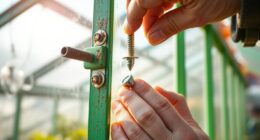When grafting greenhouse plants, you'll find techniques like cleft, whip, and bud grafting essential. You'll need quality grafting tools, including a sharp knife and securing materials like grafting clips. Maintain optimal temperatures and humidity to ensure a successful union. For tomatoes, popular rootstocks such as 'Maxifort' can boost growth. Be mindful of challenges like high costs and sanitation. Discover more about the nuances of grafting and how to maximize your greenhouse success.
Key Takeaways
- Cleft grafting and whip grafting are popular techniques for greenhouse plants, allowing for effective union between rootstock and scion.
- Maintain optimal temperatures (20°C to 25°C) and high humidity above 95% for successful graft healing in greenhouse conditions.
- Use quality grafting tools, such as a miter-cut knife and grafting clips, to ensure clean cuts and secure unions.
- Popular rootstock varieties for greenhouse tomatoes include 'Maxifort' and 'Beaufort' for enhanced growth and disease resistance.
- Strict sanitation practices are essential to prevent contamination and graft failure during the grafting process.
Types of Grafting Techniques

Grafting techniques are essential tools for greenhouse growers looking to enhance plant quality and productivity. You can choose from several methods, each tailored to specific plant needs.
Cleft grafting involves cutting a slit in the rootstock and inserting one or two scions. Whip grafting can be performed just before or after new growth starts. For inlay grafting, a V-shaped notch secures the scion. Four-flap grafting requires making four cuts on the rootstock bark to accommodate the scion. Bud grafting inserts a bud into a small incision on the rootstock. Disease and Pest Resistance is a key benefit of using grafting techniques, as it allows growers to combat soil-borne pathogens effectively.
Each technique offers unique advantages, ensuring you can effectively propagate fruit trees, ornamental plants, and vegetables while maintaining desirable traits and improving overall plant health.
Grafting Tools and Materials

To achieve successful grafting, having the right tools and materials at your disposal is important. Start with a quality grafting knife, like a miter-cut knife, which enhances speed and accuracy. You'll also need various grafting blades for precise cuts, and grafting support stakes to secure your plants during healing. Consider investing in a grafting kit that includes everything from knives to wax and tape. For securing grafts, use grafting clips, elastic grafting tape, or rubber grafting strips. Protective materials like grafting wax or Doc Farwell's Seal & Heal will help guard against moisture and pests. Additionally, using grafting support stakes can significantly aid in stabilizing your plants during the graft healing process. Lastly, keep additional accessories, like replacement blades and sanitation supplies, handy to maintain your tools and workspace. Happy grafting!
Environmental Conditions for Successful Grafting

Successful grafting hinges on optimal environmental conditions, as these factors significantly influence the healing process. Aim for temperatures between 20°C and 25°C for most plants; avoid large fluctuations to reduce stress.
Immediately after grafting, maintain high humidity above 95% to prevent wilting, then gradually decrease it as healing progresses. Initially, keep light levels low or even in darkness, then slowly increase to around 500-700 foot-candles to encourage growth. Environmental factors play a significant role in graft healing and must be carefully monitored throughout the process.
Utilize mist chambers for ideal humidity and temperature control. Remember to consider seasonal timing and regional climate, as these can affect your grafting success.
Grafting in Greenhouse Tomatoes

When you graft tomatoes in a greenhouse, you're not just merging two plants; you're enhancing their potential by combining desirable traits. Start by ensuring your seedlings are healthy and well-watered. Cut the rootstock and scion at similar angles to promote optimal healing. Use grafting clips to secure the union, maintaining cleanliness to prevent contamination. Sanitation is critical during the grafting process to prevent losses. Popular rootstock varieties like 'Maxifort' and 'Beaufort' pair well with scions such as 'Trust' and 'Cobra'. After grafting, create a high-humidity environment to aid healing, shielding the plants from excess light. In about 4-5 days, the graft union will heal, and you can gradually acclimate the plants to greenhouse conditions before transplanting them after 7-8 days.
Happy grafting!
Challenges and Considerations in Grafting

Although grafting can significantly enhance plant traits, it comes with a host of challenges that growers must navigate. High costs can strain your budget, especially with specialized materials and techniques. You'll also face high graft failure rates, which may lead to losses. Maintaining strict sanitation is crucial to prevent contamination, adding another layer of complexity. The technical intricacies of grafting demand skill and experience, while limited availability of compatible rootstocks can hinder your success. When selecting rootstocks, consider their disease resistance, vigor, and nutrient uptake; increased resistance to soil-borne diseases can be a significant advantage of using the right rootstock. Environmental factors like temperature, humidity, and soil quality also play vital roles. Ultimately, understanding these challenges will help you make informed decisions in your grafting endeavors.
Frequently Asked Questions
How Do I Choose the Right Rootstock for My Grafting Project?
To choose the right rootstock for your grafting project, consider your local soil type and climate conditions.
Look for rootstocks that show disease resistance and compatibility with your scion species.
Think about the growth rate and vigor you want, ensuring the rootstock supports your plant's needs.
Don't hesitate to seek advice from local experts or conduct trials to find the best match for your specific environment and project goals.
Can I Graft Different Plant Species Together Successfully?
Imagine a painter blending colors on a canvas; that's what grafting different plant species is like. You can graft different species together, but it's tricky. Compatibility is key, so stick to those within the same genus for better success.
Think of it as finding the right dance partner; not everyone will match. While it's possible, be prepared for some trial and error as you explore the fascinating world of interspecies grafting.
What Are the Signs of a Successful Graft?
To determine if your graft was successful, look for new growth like leaves or buds on the scion.
You should also see callus formation at the graft union, indicating healing.
Check for new vascular connections between the scion and rootstock, as these are crucial.
Make sure the scion remains turgid and doesn't wilt excessively.
Lastly, the absence of adventitious roots on the scion is a positive sign of success.
How Long Does It Take for a Graft to Heal?
When you graft, healing usually takes about 7 to 14 days.
In those initial days, the rootstock and scion start to connect, typically within 5 to 8 days.
You'll want to maintain high humidity and controlled temperatures to aid the process.
For the first few days, keep your grafts in near darkness, then gradually introduce light.
Monitoring these conditions closely will significantly enhance your chances of a successful graft healing.
Is There a Specific Time of Day to Perform Grafting?
There isn't a universally specific time of day for grafting, but many recommend doing it in the morning.
This allows you to take advantage of cooler temperatures and higher humidity levels, which are beneficial for the grafting process.
Performing grafts when plants are most hydrated can improve success rates.
Just make sure to work quickly and efficiently to minimize the time the scion and rootstock are exposed to air.
Conclusion
In the vibrant world of greenhouse gardening, mastering grafting techniques is like wielding a painter's brush, blending colors to create a masterpiece. By understanding the various methods and ensuring optimal conditions, you can nurture resilient plants that bear fruit in abundance. Embrace the challenges as stepping stones, and remember that each graft is a living testament to your skill and dedication. So, roll up your sleeves, and let your garden flourish with the magic of grafting!









